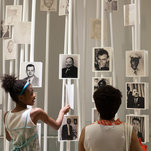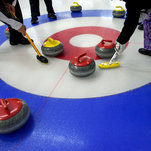When military investigators looked into an attack by American helicopters last February that left 23 Afghan civilians dead, they found that the operator of a Predator drone had failed to pass along crucial information about the makeup of a gathering crowd of villagers.
In New Military, Data Overload Can Be Deadly

At Langley Air Force Base in Virginia, teams monitor what they have nicknamed “Death TV” — live video from Afghanistan.
By THOM SHANKER and MATT RICHTEL
Published: January 16, 2011
Your Brain on Computers
Wired Warriors
Articles in this series examine how a deluge of data can affect the way people think and behave.
Doug Mills/The New York Times
For 12 hour-shifts at the Langley center, teams monitor an avalanche of images on screens.
But Air Force and Army officials now say there was also an underlying cause for that mistake: information overload.
At an Air Force base in Nevada, the drone operator and his team struggled to work out what was happening in the village, where a convoy was forming. They had to monitor the drone’s video feeds while participating in dozens of instant-message and radio exchanges with intelligence analysts and troops on the ground.
There were solid reports that the group included children, but the team did not adequately focus on them amid the swirl of data — much like a cubicle worker who loses track of an important e-mail under the mounting pile. The team was under intense pressure to protect American forces nearby, and in the end it determined, incorrectly, that the villagers’ convoy posed an imminent threat, resulting in one of the worst losses of civilian lives in the war in Afghanistan.
“Information overload — an accurate description,” said one senior military officer, who was briefed on the inquiry and spoke on the condition of anonymity because the case might yet result in a court martial. The deaths would have been prevented, he said, “if we had just slowed things down and thought deliberately.”
Data is among the most potent weapons of the 21st century. Unprecedented amounts of raw information help the military determine what targets to hit and what to avoid. And drone-based sensors have given rise to a new class of wired warriors who must filter the information sea. But sometimes they are drowning.
Research shows that the kind of intense multitasking required in such situations can make it hard to tell good information from bad. The military faces a balancing act: how to help soldiers exploit masses of data without succumbing to overload.
Across the military, the data flow has surged; since the attacks of 9/11, the amount of intelligence gathered by remotely piloted drones and other surveillance technologies has risen 1,600 percent. On the ground, troops increasingly use hand-held devices to communicate, get directions and set bombing coordinates. And the screens in jets can be so packed with data that some pilots call them “drool buckets” because, they say, they can get lost staring into them.
“There is information overload at every level of the military — from the general to the soldier on the ground,” said Art Kramer, a neuroscientist and director of the Beckman Institute, a research lab at the University of Illinois.
The military has engaged researchers like Mr. Kramer to help it understand the brain’s limits and potential. Just as the military has long pushed technology forward, it is now at the forefront in figuring out how humans can cope with technology without being overwhelmed by it.
At George Mason University in Virginia, researchers measure the brain waves of study subjects as they use a simulation of the work done at the Nevada Air Force base.
On a computer screen, the subjects see a video feed from one drone and the locations of others, along with instructions on where to direct them. The subjects wear a cap with electrodes attached, measuring brain waves. As the number of drones and the pace of instructions increases, the brain shows sharp spikes in a kind of electrical activity called theta — cause for concern among the researchers.
“It’s usually an index of extreme overload,” said Raja Parasuraman, a director of the university’s human factors and applied cognition program.
As the technology allows soldiers to pull in more information, it strains their brains. And military researchers say the stress of combat makes matters worse. Some research even suggests that younger people wind up having more trouble focusing because they have grown up constantly switching their attention.
For the soldier who has been using computers and phones all his life, “multitasking might actually have negative effects,” said Michael Barnes, research psychologist at the Army Research Lab at Aberdeen, Md., citing several university studies on the subject.
In tests at a base in Orlando, Mr. Barnes’s group has found that when soldiers operate a tank while monitoring remote video feeds, they often fail to see targets right around them.
Mr. Barnes said soldiers could be trained to use new technology, “but we’re not going to improve the neurological capability.”
On the other hand, he said, the military should not shy away from improving the flow of data in combat. “It would be like saying we shouldn’t have automobiles because we have 40,000 people die on the roads each year,” he said. “The pluses of technology are too great.”
The military is trying novel approaches to helping soldiers focus. At an Army base on Oahu, Hawaii, researchers are training soldiers’ brains with a program called “mindfulness-based mind fitness training.” It asks soldiers to concentrate on a part of their body, the feeling of a foot on the floor or of sitting on a chair, and then move to another focus, like listening to the hum of the air-conditioner or passing cars.
“The whole question we’re asking is whether we can rewire the functioning of the attention system through mindfulness,” said one of the researchers, Elizabeth A. Stanley, an assistant professor of security studies at Georgetown University. Recently she received financing to bring the training to a Marine base, and preliminary results from a related pilot study she did with Amishi Jha, a neuroscientist at the University of Miami, found that it helped Marines to focus.
Even as it worries about digital overload, the Army is acknowledging that technology may be the best way to teach this new generation of soldiers — in particular, a technology that is already in their pockets. In Army basic training, new recruits can get instruction from iPhone apps on subjects as varied as first aid and military values.
As part of the updated basic training regimen, recruits are actually forced into information overload — for example, testing first aid skills while running an obstacle course.
“It’s the way this generation learns,” said Lt. Gen. Mark P. Hertling, who oversees initial training for every soldier. “It’s a multitasking generation. So if they’re multitasking and combining things, that’s the way we should be training.”
The intensity of warfare in the computer age is on display at a secret intelligence and surveillance installation at Langley Air Force Base in Virginia, a massive, heavily air-conditioned warehouse where hundreds of TVs hang from black rafters. Every day across the Air Force’s $5 billion global surveillance network, cubicle warriors review 1,000 hours of video, 1,000 high-altitude spy photos and hundreds of hours of “signals intelligence” — usually cellphone calls.
At the Langley center, officially called Distributed Common Ground System-1, heavy multitasking is a daily routine for people like Josh, a 25-year-old first lieutenant (for security reasons, the Air Force would not release his full name). For 12 hours a day, he monitors an avalanche of images on 10 overhead television screens. They deliver what Josh and his colleagues have nicknamed “Death TV” — live video streams from drones above Afghanistan showing Taliban movements, suspected insurgent safehouses and American combat units headed into battle.
As he watches, Josh uses a classified instant-messaging system showing as many as 30 different chats with commanders at the front, troops in combat and headquarters at the rear. And he is hearing the voice of a pilot at the controls of a U-2 spy plane high in the stratosphere.
“I’ll have a phone in one ear, talking to a pilot on the headset in the other ear, typing in chat at the same time and watching screens,” Josh says. “It’s intense.”
The stress lingers when the shift is over. Josh works alongside Anthony, 23, an airman first class who says his brain hurts each night, the way feet ache after a long march.
“You have so much information coming in that when you go home — how do you take that away? Sometimes I work out,” Anthony said. “Actually, one of my things is just being able to enjoy a nice bowl of cereal with almond milk. I feel the tension is just gone and I can go back again.”
Video games don’t do the trick. “I need something real,” he said.











